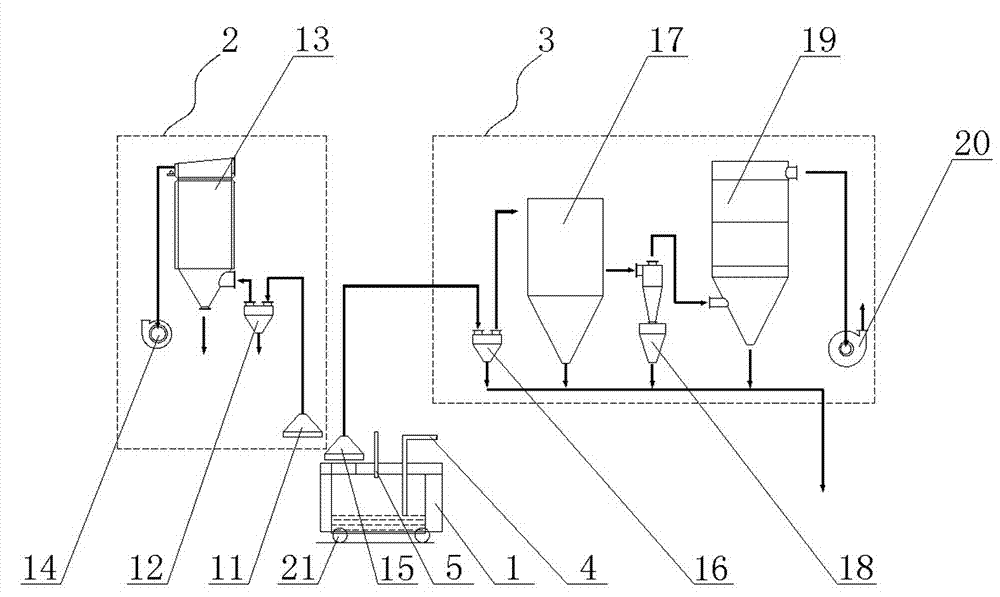Device and method for producing stannic oxide through self-heating way
A technology of tin dioxide and self-heating method, applied in the direction of tin oxide, etc., can solve the problems of high technical requirements, high relative cost, high equipment investment, etc., and achieve the effect of improving product quality, stable and reliable equipment operation, and ensuring purity
- Summary
- Abstract
- Description
- Claims
- Application Information
AI Technical Summary
Problems solved by technology
Method used
Image
Examples
Embodiment 1
[0040]The steps are as follows: move the autothermal oxidation furnace 1 to the ambient cooling dust collection system 2, turn on the centrifugal fan 14 of the ambient cooling dust collection system 2, align the smoke exhaust port 7 with the fume hood 11, and use natural gas to heat up to 1200°C. Add tin ingots from the feeding port 6 to start melting, observe the height of the tin liquid from the operating port 9 to 300mm, then the furnace temperature drops to 1000°C, continue heating to the furnace temperature of 1200°C, stop heating, and move the autothermal oxidation furnace 1 Go to the main process cooling dust collection system 3, make the main process hood 15 dock with the smoke exhaust port 7, open the main process centrifugal fan 20, slowly lower the spray gun 4, insert it into the self-heating oxidation furnace 1 from the spray gun hole 8, and pass it into For primary air and fuel, insert the secondary air pipe 5 into the secondary air port 10 to blow secondary air; o...
Embodiment 2
[0043] Move the autothermal oxidation furnace 1 to the ambient cooling dust collection system 2, turn on the centrifugal fan 14 of the ambient cooling dust collection system 2, align the exhaust port 7 with the fume hood 11, use natural gas to heat up to 1211°C, and 6. Add tin ingots and start melting. Observe the height of the tin liquid from the operating port 9 to 320mm. At this time, the furnace temperature drops to 1000°C, continue heating to the furnace temperature of 1280°C, stop heating, and move the autothermal oxidation furnace 1 to the main process Cool the dust collection system 3, make the main process fume hood 15 dock with the smoke exhaust port 7, turn on the main process centrifugal fan 20, lower it slowly, insert the spray gun 4 from the spray gun hole 8 into the autothermal oxidation furnace 1, and pass in primary air and fuel , insert the secondary air pipe 5 into the secondary air port 10 to blow the secondary air; open the primary air pipe valve and the se...
Embodiment 3
[0045] Move the autothermal oxidation furnace 1 to the ambient cooling dust collection system 2, turn on the centrifugal fan 14 of the ambient cooling dust collection system 2, align the exhaust port 7 with the fume hood 11, use natural gas to heat up to 1230°C, 6 Add tin ingots and start to melt. Observe the height of the tin liquid from the operating port 9 to 280mm. At this time, the furnace temperature drops to 1000°C, continue heating to the furnace temperature of 1240°C, stop heating, and move the autothermal oxidation furnace 1 to the main process Cool the dust collection system 3, make the main process fume hood 15 dock with the smoke exhaust port 7, turn on the main process centrifugal fan 20, lower it slowly, insert the spray gun 4 from the spray gun hole 8 into the autothermal oxidation furnace 1, and pass in primary air and fuel , insert the secondary air pipe 5 into the secondary air port 10 to blow the secondary air; open the primary air pipe valve and the seconda...
PUM
| Property | Measurement | Unit |
|---|---|---|
| particle size | aaaaa | aaaaa |
| particle size | aaaaa | aaaaa |
| whiteness | aaaaa | aaaaa |
Abstract
Description
Claims
Application Information
 Login to View More
Login to View More - R&D
- Intellectual Property
- Life Sciences
- Materials
- Tech Scout
- Unparalleled Data Quality
- Higher Quality Content
- 60% Fewer Hallucinations
Browse by: Latest US Patents, China's latest patents, Technical Efficacy Thesaurus, Application Domain, Technology Topic, Popular Technical Reports.
© 2025 PatSnap. All rights reserved.Legal|Privacy policy|Modern Slavery Act Transparency Statement|Sitemap|About US| Contact US: help@patsnap.com



